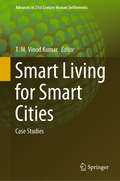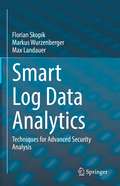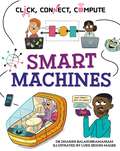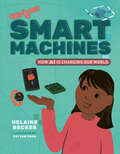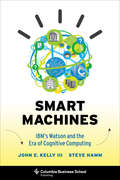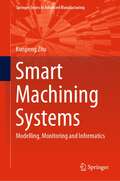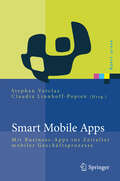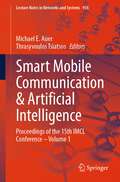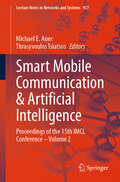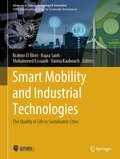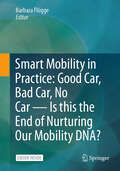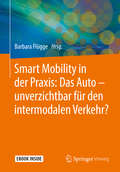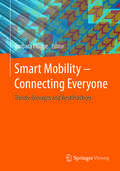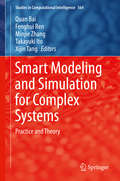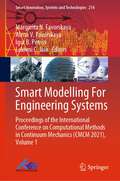- Table View
- List View
Smart Living for Smart Cities: Case Studies (Advances in 21st Century Human Settlements)
by T. M. Vinod KumarThis book, based on extensive international collaborative research, highlights the state-of-the-art design of “smart living” for metropolises, megacities, and metacities, as well as at the community and neighbourhood level. Smart living is one of six main components of smart cities, the others being smart people, smart economy, smart environment, smart mobility and smart governance. Smart living in any smart city can only be designed and implemented with active roles for smart people and smart city government, and as a joint effort combining e-Democracy, e-Governance and ICT-IoT systems. In addition to using information and communication technologies, the Internet of Things, Internet of Governance (e-Governance) and Internet of People (e-Democracy), the design of smart living utilizes various domain-specific tools to achieve coordinated, effective and efficient management, development, and conservation, and to improve ecological, social, biophysical, psychological and economic well-being in an equitable manner without compromising the sustainability of development ecosystems and stakeholders. This book presents case studies covering more than 10 cities and centred on domain-specific smart living components. The book is issued in two volumes. and this volume focus on city studies.
Smart Living for Smart Cities: Community Study, Ways and Means (Advances in 21st Century Human Settlements)
by T. M. Vinod KumarThis book, based on extensive international collaborative research, highlights the state-of-the-art design of smart living for metropolises, megacities, and metacities, as well as at the community and neighbourhood level. Smart living is one of six main components of smart cities, the others being smart people, smart economy, smart environment, smart mobility and smart governance. Smart living in any smart city can only be designed and implemented with active roles for smart people and smart city government, and as a joint effort combining e-Democracy, e-Governance and ICT-IoT systems. In addition to using information and communication technologies, the Internet of Things, Internet of Governance (e-Governance) and Internet of People (e-Democracy), the design of smart living utilizes various domain-specific tools to achieve coordinated, effective and efficient management, development, and conservation, and to improve ecological, social, biophysical, psychological and economic well-being in an equitable manner without compromising the sustainability of development ecosystems and stakeholders. This book presents case studies covering more than 10 cities and centred on domain-specific smart living components. The book is issued in two volumes and this volume focus on community studies and ways and means.
Smart Log Data Analytics: Techniques for Advanced Security Analysis
by Florian Skopik Markus Wurzenberger Max LandauerThis book provides insights into smart ways of computer log data analysis, with the goal of spotting adversarial actions. It is organized into 3 major parts with a total of 8 chapters that include a detailed view on existing solutions, as well as novel techniques that go far beyond state of the art. The first part of this book motivates the entire topic and highlights major challenges, trends and design criteria for log data analysis approaches, and further surveys and compares the state of the art. The second part of this book introduces concepts that apply character-based, rather than token-based, approaches and thus work on a more fine-grained level. Furthermore, these solutions were designed for “online use”, not only forensic analysis, but also process new log lines as they arrive in an efficient single pass manner. An advanced method for time series analysis aims at detecting changes in the overall behavior profile of an observed system and spotting trends and periodicities through log analysis. The third part of this book introduces the design of the AMiner, which is an advanced open source component for log data anomaly mining. The AMiner comes with several detectors to spot new events, new parameters, new correlations, new values and unknown value combinations and can run as stand-alone solution or as sensor with connection to a SIEM solution. More advanced detectors help to determines the characteristics of variable parts of log lines, specifically the properties of numerical and categorical fields.Detailed examples throughout this book allow the reader to better understand and apply the introduced techniques with open source software. Step-by-step instructions help to get familiar with the concepts and to better comprehend their inner mechanisms. A log test data set is available as free download and enables the reader to get the system up and running in no time.This book is designed for researchers working in the field of cyber security, and specifically system monitoring, anomaly detection and intrusion detection. The content of this book will be particularly useful for advanced-level students studying computer science, computer technology, and information systems. Forward-thinking practitioners, who would benefit from becoming familiar with the advanced anomaly detection methods, will also be interested in this book.
Smart Machines (Click, Connect, Compute #2)
by Dharini BalasubramaniamSmart machine fundamentals, using clear, expert explanations and comic illustrations to spark interest and enthusiasm in the next generation of computer scientists!Click, Connect, Compute: Smart Machines uncovers how machine that can learn are created and how they operate. Readers will discover the meaning of Artificial Intelligence (AI), the benefits of teamwork in tech, and the role that the 'Internet of Things' plays in helping homes, hospitals and cities run. And the end of the book fast-forwards to the future of computer science, robotics and AI and considers what it might mean to live in a 'smarter' world.Contents: What are smart machines? / Smart machine fundamentals / Putting together a smart machine / What's AI got to do with it? / Data's part to play / The Internet of Things (IoT) / Making smart spaces / Are robots smart? / The rise of smart machines / Just how smart are smart machines? / The rights and wrongs of using smart machines / The future of smart machines / Pioneer portraits / Further information / Glossary / Quiz yourself! / IndexThe Click, Connect, Compute series untangles the computer science web and teaches children about the essentials of computer software, hardware and digital literacy as well as discussing the ethics surrounding this evolving field. Featuring fun, friendly comic strip illustrations, pioneer bios and a quiz, this is a perfect read for children aged 8+.Books in the series: Computer Science Essentials / Data, Big and Small / Smart Machines / The Languages of ProgrammingWritten in a clear, thoughtful way by computer science expert, Dr. Dharini Balasubramaniam, a strong advocate for ethics and education in her field.
Smart Machines: How AI is Changing Our World (Orca Think)
by Helaine BeckerDid you ask Siri for directions to soccer practice today or use face recognition to log on to your phone? That’s AI. The latest generation of tech tools uses artificial intelligence to perform everyday tasks. AI can speed up repetitive jobs and even be used in software to help with medical diagnoses. But when the intellectual property of writers, actors and artists is uploaded into AI systems and used without permission, AI can cause harm. In Smart Machines, young readers will look at the history of AI, how it works, how it’s used for good and bad and the ethical issues it raises. They’ll also discover how the risks of AI can be managed through responsible design, regulation and in the individual choices people make about which tools to use or those to avoid. AI isn’t intelligent, but it’s a tool that is revolutionizing robotics and computer programming—and it could change humanity forever. The epub edition of this title is fully accessible.
Smart Machines: IBM's Watson and the Era of Cognitive Computing (Columbia Business School Publishing)
by Steve Hamm John Kelly IIIWe are crossing a new frontier in the evolution of computing and entering the era of cognitive systems. The victory of IBM's Watson on the television quiz show Jeopardy! revealed how scientists and engineers at IBM and elsewhere are pushing the boundaries of science and technology to create machines that sense, learn, reason, and interact with people in new ways to provide insight and advice.In Smart Machines, John E. Kelly III, director of IBM Research, and Steve Hamm, a writer at IBM and a former business and technology journalist, introduce the fascinating world of "cognitive systems" to general audiences and provide a window into the future of computing. Cognitive systems promise to penetrate complexity and assist people and organizations in better decision making. They can help doctors evaluate and treat patients, augment the ways we see, anticipate major weather events, and contribute to smarter urban planning. Kelly and Hamm's comprehensive perspective describes this technology inside and out and explains how it will help us conquer the harnessing and understanding of "big data," one of the major computing challenges facing businesses and governments in the coming decades. Absorbing and impassioned, their book will inspire governments, academics, and the global tech industry to work together to power this exciting wave in innovation.
Smart Machining Systems: Modelling, Monitoring and Informatics (Springer Series in Advanced Manufacturing)
by Kunpeng ZhuThis book provides the tools to enhance the precision, automation and intelligence of modern CNC machining systems. Based on a detailed description of the technical foundations of the machining monitoring system, it develops the general idea of design and implementation of smart machining monitoring systems, focusing on the tool condition monitoring system. The book is structured in two parts. Part I discusses the fundamentals of machining systems, including modeling of machining processes, mathematical basics of condition monitoring and the framework of TCM from a machine learning perspective. Part II is then focused on the applications of these theories. It explains sensory signal processing and feature extraction, as well as the cyber-physical system of the smart machining system. Its utilisation of numerous illustrations and diagrams explain the ideas presented in a clear way, making this book a valuable reference for researchers, graduate students and engineers alike.
Smart Manufacturing Blueprint: Navigating Industry 4.0 Across Diverse Sectors (Springer Series in Advanced Manufacturing)
by Wasim Ahmed Khan Muhammad Hammad Hassan Ali Manos PanaousisThis book is a crucial guidebook for understanding and implementing smart manufacturing technologies in the dynamic Industry 4.0 era. The book covers industries from automotive to aerospace, electronics to pharmaceuticals and explores the integration of IoT, AI, big data, robotics, and cyber-security into traditional manufacturing processes. It provides actionable frameworks, detailed case studies, and a step-by-step guide to transitioning into smart manufacturing paradigms. Key features include: Illustrated guides and frameworks tailored for a wide array of sectors. Real-world case studies demonstrating successful implementation strategies. A novel focus on sustainability and security within the smart manufacturing sphere. Insights into future trends, preparing readers for the next digital transformation wave. This book is an indispensable resource for professionals, policymakers, and academics seeking to harness the power of Industry 4.0 technologies to innovate, compete, and thrive in the connected world of tomorrow.
Smart Medical Imaging for Diagnosis and Treatment Planning
by Nilanjan Dey, Bitan Misra, and Sayan ChakrabortyThis book presents advanced research on smart health technologies, focusing on the innovative transformations in diagnosis and treatment planning using medical imaging and data analysed by data science techniques. It shows how smart health technologies leverage artificial intelligence (AI) and big data analytics to provide more accurate and efficient diagnosis and treatment planning. In search for innovative and novel methods and techniques for health technologies and medical data processing, the book • Discusses applications of Artificial Intelligence, Data Science, Machine Learning, Deep Learning, the Internet of Things, Big Data, Cloud Computing;• Includes use of electronic patient records in healthcare, analysis of big data in medical diagnosis, reliability, and challenges of EPR and EHR in smart healthcare;• Explores evolving techniques for smart healthcare, its application in medical imaging and prediction in the fields of treatment planning;• Provides recent studies in AI-driven healthcare technologies and medical imaging to outline insight into smart healthcare technologies;• Discusses the role of big data in smart healthcare, computing techniques for healthcare for medical diagnosis and treatment planning;• Encompasses the ethical and legal challenges of using smart healthcare and medical data.This book serves as a valuable reference for researchers working on smart health technologies. Researchers of medical imaging, artificial intelligence, and data science along with healthcare domain will find it a great resource as well.
Smart Meters: Artificial Intelligence to Support Proactive Management of Energy Consumption (Lecture Notes in Energy #97)
by Djaffar Ould AbdeslamThis book describes how equipping buildings with smart meters is essential to improve the prediction of energy costs within smart grids and to help end-users optimize their energy consumption. The book reports on the results of the European Upper Rhine INTERREG project SMI (www.smi.uha.fr), which connects artificial intelligence and micro-societal analysis. It is multidisciplinary and addresses the following aspects: social, legal, environmental, and technical.One of the critical factors for the transition to clean energy is the flexibility of the power grid. A flexible grid requires a constant flow of data about the network and its demand, on the other hand, clients who produce electrical power can be an active part of the demand response if they are informed about the power needs of their appliances.“If you cannot measure it, you cannot improve it.” This common management saying also holds true for the area energy efficiency. Without a clear understanding of their energy usage, consumers are unable to take steps to reduce their consumption. A new intelligent tool is presented that is more efficient, safe, and acceptable to consumers. Thus, users of this intelligent tool will be able to collect and predict the consumption of their electrical appliances. At the same time, the consumption information is anonymized before being relayed to the energy supplier. In parallel, new techniques will be evaluated to improve the security level of the smart meter in a highly heterogeneous network.
Smart Micro-Grid Systems Security and Privacy (Advances in Information Security #71)
by Christoph Meinel Anne V. Kayem Stephen D. WolthusenThis book is centered on Smart grids and micro-grids, as a cost-effective method of ensuring fair and equitable access to power in urban areas. It also considers scenarios where deploying smart grids can be both cost-prohibitively expensive and logistically challenging. Deploying smart microgrids instead, offers a reliable power solution but, as is the case in smart grids, a key issue is guaranteeing usability, trust, and reliability while protecting against energy theft. This book considers aspects such as state estimation, capacity planning, demand forecasting, price signals, and demand management with respect to energy theft. Straight-forward approaches to provoking energy theft on smart grids and micro-grids include mis-recordings power consumption/generation information and exposures of personally identifiable information or sensitive information. Attack models based on mis-recorded generation and/or consumption data and exposure of personally identifiable information, are also studied. In each case, countermeasures are proposed to circumvent the power theft attacks raised. Researchers in Smart Micro-grids security, cyber-physical systems, and critical infrastructure will want to purchase this book as a reference. Professionals, Researchers, Academics and students working in security general and Security of Critical Infrastructure, Privacy, and Data Sharing will also want to purchase this book as a reference.
Smart Microgrids: From Design to Laboratory-Scale Implementation
by Shahab Bahrami Ali MohammadiIn this book the authors first provide a comprehensive survey on the available studies on control, management, and optimization strategies in AC and DC microgrids. The authors then provide the design of a laboratory-scale microgrid system. Finally, a real-world implementation of the deigned framework is provided. This book paves the way for researchers working on the smart microgrids spread over the fields of electrical engineering, power systems, and smart infrastructures. Furthermore, it provides the readers with a comprehensive insight to understand an in-depth big picture of smart microgrids as well as an all-inclusive framework for laboratory-scale implementation of a microgrid. It is suitable for senior undergraduate students, graduate students who are interested in research in areas related to future smart grids and microgrids, and the researchers working in the related areas. This book also can be used as a reference book for researchers who want to develop laboratories on smart microgrids for future research.
Smart Microgrids: Lessons from Campus Microgrid Design and Implementation
by Russell L. HermanThe utility sector’s transition to renewable energy and the smart grid has already begun. The first step towards smart grid is microgrid, which is a smaller electricity grid with access to all the essential assets of a larger grid. This book provides a glimpse into an actual microgrid project. It supplies a system-level approach to the design of smart Microgrids, covering the entire design process—from roadmap to realization. Detailing lessons learned and pitfalls to avoid in Microgrid technology, the book provides an interdisciplinary approach to design and problem solving for smart microgrids.
Smart Mobile Apps: Mit Business-Apps ins Zeitalter mobiler Geschäftsprozesse
by Stephan Verclas Claudia Linnhoff-PopienMobile Apps - Programme, die auf Smartphones ausgeführt werden - sind derzeit fast nur bei Konsumenten erfolgreich. Ein echtes App-Konzept für den Business-Markt fehlt nach wie vor. Die Autoren zeigen in dem Band den Weg zu intelligenten Business-Apps für mobile Geschäftsprozesse, mit deren Hilfe Kunden zeitnah und individuell informiert werden können. Die Autoren betrachten Fragen der Anwendung, der Technologie und des Marktes und berücksichtigen auch Cloud-Lösungen.
Smart Mobile Communication & Artificial Intelligence: Proceedings of the 15th IMCL Conference – Volume 1 (Lecture Notes in Networks and Systems #936)
by Michael E. Auer Thrasyvoulos TsiatsosInteractive mobile technologies are today the core of many—if not all—fields of society. Not only the younger generation of students expects a mobile working and learning environment. And nearly daily new ideas, technologies, and solutions boost this trend. To discuss and assess the trends in the interactive mobile field are the aims connected with the 15th International Conference on Interactive Mobile Communication, Technologies, and Learning (IMCL2023), which was held 9–10 November 2023. Since its beginning in 2006, this conference is devoted to new approaches in interactive mobile technologies with a focus on learning. Nowadays, the IMCL conferences are a forum of the exchange of new research results and relevant trends as well as the exchange of experiences and examples of good practice. Interested readership includes policy makers, academics, educators, researchers in pedagogy and learning theory, schoolteachers, learning Industry, further education lecturers, etc.
Smart Mobile Communication & Artificial Intelligence: Proceedings of the 15th IMCL Conference – Volume 2 (Lecture Notes in Networks and Systems #937)
by Michael E. Auer Thrasyvoulos TsiatsosInteractive mobile technologies are today the core of many—if not all—fields of society. Not only the younger generation of students expects a mobile working and learning environment. And nearly daily new ideas, technologies, and solutions boost this trend. To discuss and assess the trends in the interactive mobile field are the aims connected with the 15th International Conference on Interactive Mobile Communication, Technologies, and Learning (IMCL2023), which was held 9–10 November 2023. Since its beginning in 2006, this conference is devoted to new approaches in interactive mobile technologies with a focus on learning. Nowadays, the IMCL conferences are a forum of the exchange of new research results and relevant trends as well as the exchange of experiences and examples of good practice. Interested readership includes policy makers, academics, educators, researchers in pedagogy and learning theory, schoolteachers, learning Industry, further education lecturers, etc.
Smart Mobility
by Barbara FlüggeDas Herausgeberwerk bietet einen umfassenden Zugang zum Trendthema Smart Mobility: ausgehend von sozio-ökologischen und sozio-ökonomischen Aspekten der Mobilität, den Anforderungen von Anbietern und Nachfragern bis hin zu Mobilitätsansprüchen ganzer Ökosysteme und der Anwendbarkeit digitaler Lösungen für die Lebensbereiche jedes Einzelnen. Das Buch setzt wirkungsvoll die Ausgangssituation im Bereich Mobilität in Kontext mit den unterschiedlichsten Nutzungsszenarien und Initiativen. Die Leserschaft erhält einen Fahrplan für die Mobilität in Zeiten der Digitalisierung: Bausteine Intelligenter Mobilität (BIM), ein Vorgehensmodell und eine Reihe praxisorientierter Handlungsempfehlungen erleichtern die Analyse-, Planungs- und Umsetzungsphasen von Mobilitätsvorhaben.Die Beschreibungen erfolgen bewusst anschaulich und nachvollziehbar durch Checklisten und Anleitungen. Damit richtet sich das Buch an alle Entscheider, Innovationstreiber und Vordenker aus der Praxis, die sich mit dem Thema Mobilität beschäftigen – sei es im Personen- oder Frachtverkehr.
Smart Mobility and Industrial Technologies: The Quality of Life in Sustainable Cities (Advances in Science, Technology & Innovation)
by Mohammed Essaaidi Rajaa Saidi Brahim El Bhiri Naima KaabouchThis book discusses many issues related to the impact of advanced technologies on quality of human life. It covers several areas and use cases that illustrate how technologies could be harnessed to solve all kinds of humanity issues in areas as diverse as education, health care, industry, agriculture, mobility, etc. Specially, it aims at establishing the vital link between advances in technology and sustainable development to magnify the benefits. This book covers a wide range of audience including academic/research, professors, scientists, and engineers working in different fields, comprising engineering, sustainability, as well as government and international organizations officials interested in sustainable planning. This is done through a set of selected papers from those presented to 4th International Conference on Advanced Technologies for Humanity (ICATH'2022) which was organized by the Moroccan School of Engineering Sciences (EMSI) in collaboration with national and international institutions. ICATH22 was held in Marrakech, from November 11 to 12, 2022. Key topics showcasing how technology can serve humanity in different ways and facets of human life, activities, and challenges are covered in depth through the chapters of this book which are presented in four different sections, namely:1. Advanced Technologies for smart Mobility in Smart Cities.2. Emerging Technologies for Connectivity in Sustainable Cities.3. Transitioning to Sustainable Industrial Engineering. 4. Technology for Human Sciences as Key Components of Sustainability.
Smart Mobility in Practice: Good Car, Bad Car, No Car – Is this the End of Nurturing Our Mobility DNA?
by Barbara FlüggeThis non-fictional, yet storytelling, book questions the role of cars and their impact, both for now and in the future. It is not enough to just consider autonomous driving, driving bans in Europe, and combustion engines. Our future and the future of our cities and country living depend on how we can coordinate different needs and different means. Finally, we ask ourselves: What is the status of the car today and in the future? Are we living and working in vehicles more than ever? And who benefits from autonomous driving and what are we giving up for it? In this book, the editor's work illustrates and critically assesses the role of cars. It showcases project examples and introduces easy to use checklists. The authors show how the car influences our business and private lives, and how the car stimulates our appetite for adventures, recreation, and survival. Emerging throughout more than a century, purposefully deployed, and innovativelyused, the automobile grew into our mobility DNA beyond horsepower and equipment. The car has been evolving into an adventure space, a survival and a growth space. The editor and authoring team present innovative services, digital use cases and smart data that are worth considering. The concept of Smart Mobility offers the possibility to retrieve the appropriate means of transport for individual and freight traffic in a forward-looking, digital, and intermodal way. Smart Mobility in practice: Good car, bad car, no car by DoktorB Barbara Fluegge and team is aimed at decision-makers and entrepreneurs, as well as project managers and their teams, in the context of smart city and digitail transformation projects. Numerous checklists and a comprehensive glossary make the book an important tool for practical use in pre- and post-preparation of projects and lectures in the field of Smart Mobility, Smart City, Smart Regions. Business Development and Digital Humanism.
Smart Mobility in der Praxis: Das Auto – unverzichtbar für den intermodalen Verkehr?
by Barbara FlüggeDie Zukunft der Städte und Ballungsräume hängt zunehmend davon ab, wie Verkehrsteilnehmer ihre unterschiedlichen Bedürfnisse koordinieren. Das Konzept der Smart Mobility bietet die Möglichkeit, die geeigneten Transportmittel für Individual- und Frachtverkehr vorausschauend, digital und intermodal abzurufen. Davon profitieren die Verkehrsteilnehmer, aber auch unser Ökosystem. Dieses Fachbuch wirft einen Blick hinter das Konzept einer durch Digitalisierung gestützten intelligenten Mobilität. Es illustriert Vorgehensweisen und Fragestellungen anhand von fiktiven wie realitätsnahen Projektierungsbeispielen in Städten und Regionen und behandelt zentrale Fragen: Wie lassen sich Mobilitätsszenarien ganzheitlich einschätzen und erfassen? Welches sind die wesentlichen Schritte, die es dabei zu berücksichtigen gilt?Das Einführungskapitel stellt das Konzept „Smart Mobility“ vor und erläutert verschiedene Projektierungsansätze sowie die Bausteine Intelligenter Mobilität (BIM). Zehn Fallbeispielen, unter anderem zum Autonomen Fahren, zu intelligenten Verkehrsknotenpunkten, zum Erlebnisraum Auto und der E-Mobilität, zeigen praxisnah, wie die Tools, Vorgehensweisen und BIM anzuwenden sind. Zahlreiche Checklisten und Abbildungen unterstreichen darüber hinaus den Praxisbezug dieses Werkes. Das Begleitbuch zu „Smart Mobility“ von Barbara Flügge, Digitalisierungsexpertin und Beraterin, richtet sich an Entscheider und Unternehmer sowie an Projektleiter und -mitarbeiter im Rahmen von Smart-City-Vorhaben. Außerdem eignet sich dieser Band ideal zur Vor- und Nachbereitung von Lehrveranstaltungen zu Themen wie Smart Cities oder Urban Systems Research.
Smart Mobility – Connecting Everyone
by Barbara FlüggeThis book presents a comprehensive overview of various aspects of mobility and transportation to be smart and seamless. It provides basic principles and trends of smart mobility as well as international examples. The topic of this work is especially interesting as the future of human centered and business triggered ecosystems is increasingly dependent on the coordination capabilities of all participating and influencing members to manage transportation needs. Even more the fulfillment of the right to mobility for individual and cargo related mobility asks for mobility enablement in a predictive, digital and intermodal manner. Therefore, this book is useful not only for decision makers in several positions but also for people who are interested in trends of transportation and mobility.
Smart Mobility: Exploring Foundational Technologies and Wider Impacts
by Alaa KhamisEach year we witness several paradigm shifts in mobility systems and services, increasingly so as technology progresses. The future of mobility is people-centric, software-defined, connected, and electric. Now more than ever, it is imperative for current and aspiring leaders in the field to understand the foundations of people-centric smart cities with a focus on sustainability. Smart Mobility offers a holistic view of the current and emerging smart mobility systems and explores their foundational technologies, technology enablers, and disruptors. Author Alaa Khamis acknowledges the need for smart mobility arising with growing world urbanization, and the impact of this on public health, congestion, and climate change. Khamis expertly interrogates how a focus on smart mobility can mitigate all of these risks using his triad of complementary factors: technology, governance, and city planning. In this book you’ll study how foundational technologies such as artificial intelligence, blockchain, the Internet of Things, robotics, and many more all work together to allow for smart mobility in our modern era. Khamis additionally covers the topical events of the COVID-19 pandemic and analyzes its impact on consumer behavior and the expected short-term disruptions and longer-term structural changes. The socioeconomic changes in our urban centers are vast, and Smart Mobility breaks down the core concepts with meaningful data and insights.What You Will LearnExplore different mobility modes, including mobility-as-a-service, shared mobility, mobility on demand, the gig economy and the passenger economyCover how the smart mobility triad - technology, governance, and city planning - work together to create a smart and sustainable mobilitySee how the COVID-19 pandemic is impacting consumer behavior and preferences and changing the future of mobilityWho This Book Is ForWorking professionals, students, researchers, technologists, city planners, and the curious layman.
Smart Mobility: Trends, Konzepte, Best Practices für die intelligente Mobilität
by Barbara FlüggeMit diesem Buch gelingt der Einstieg in das Trendthema „Smart Mobility“Dieses Buch bietet Ihnen einen umfassenden Zugang zum aktuellen Trendthema Smart Mobility. Die thematisch vielfältigen Beiträge maßgeblicher Expertinnen und Experten – zusammengetragen von Herausgeberin Barbara Flügge – beleuchten u. a. folgende Schwerpunkte:• Sozio-ökologische und sozio-ökonomische Aspekte der Mobilität• Die Anforderungen von Anbietern und Nachfragern• Mobilitätsansprüche ganzer Ökosysteme (Stadt, Land und Ballungsräume)• Anwendbarkeit digitaler Lösungen für die Lebensbereiche jedes EinzelnenMit diesem Setup setzt das Buch wirkungsvoll die Ausgangssituation in der Smart Mobility in den Kontext von unterschiedlichsten Nutzungsszenarien und Initiativen. Die Beiträge erläutern einzelne Bausteine Intelligenter Mobilität (BIM) und Vorgehensmodelle. Zudem liefert Ihnen dieses Herausgeberwerk zahlreiche praxisorientierte Handlungsempfehlungen und Best Practices, die Ihnen die Analyse-, Planungs- und Umsetzungsphasen von Mobilitätsvorhaben erleichtern. Damit richtet sich dieses Buch über Smart Mobility in erster Linie an:a) Chief Digital Officersb) Entscheider in öffentlichen Verwaltungen und in der Privatwirtschaftc) Innovationstreiber und Entrepreneure aus der Praxis d) Projektleiter und -mitarbeiter – sei es im Personen- oder FrachtverkehrDie Gegenwart und Zukunft im BlickUm Ihnen den Einstieg zu erleichtern, geben Ihnen die Beiträge zunächst einen Überblick über das große Themenfeld der Smart Mobility. Hier erfahren Sie, welche Vorgehensweisen sich zur Bewertung von Mobilität eignen, wodurch sich das Kauf- und Nutzverhalten im Personenverkehr heutzutage auszeichnet und wie Sie ein sicheres sowie nachhaltiges Verkehrsmanagement gestalten können. Weitere inhaltliche Schwerpunkte dieses Buchs sind:• Indoor- und Outdoor-Navigation in Smart Mobility-Szenarien• Inter- und multimodale Routenplanung• Smart Ticketing• Mobilitätsrelevante Diagnostik• Bausteine Intelligenter Mobilität für die Zukunft• Das Smart Mobility VorgehensmodellEin umfassendes GrundlagenwerkMit der zweiten aktualisierten Auflage bringt Ihnen dieses Buch den Themenkomplex der Smart Mobility anschaulich und nachvollziehbar näher. Die inhaltliche Mischung aus theoretischem Basiswissen sowie aktuellen Trends (wie z. B. Mega Cities oder Zero Traffic) und hilfreichen Checklisten machen dieses Werk zu einem nachvollziehbaren und anschaulichen Grundlagenwerk für alle Themeninteressierten.
Smart Modeling and Simulation for Complex Systems
by Quan Bai Fenghui Ren Minjie Zhang Takayuki Ito Xijin TangThis book aims to provide a description of these new Artificial Intelligence technologies and approaches to the modeling and simulation of complex systems, as well as an overview of the latest scientific efforts in this field such as the platforms and/or the software tools for smart modeling and simulating complex systems. These tasks are difficult to accomplish using traditional computational approaches due to the complex relationships of components and distributed features of resources, as well as the dynamic work environments. In order to effectively model the complex systems, intelligent technologies such as multi-agent systems and smart grids are employed to model and simulate the complex systems in the areas of ecosystem, social and economic organization, web-based grid service, transportation systems, power systems and evacuation systems.
Smart Modelling For Engineering Systems: Proceedings of the International Conference on Computational Methods in Continuum Mechanics (CMCM 2021), Volume 1 (Smart Innovation, Systems and Technologies #214)
by Lakhmi C. Jain Margarita N. Favorskaya Alena V. Favorskaya Igor B. PetrovThis book is a collection of research papers selected for presentation at the International Conference on Smart Computational Methods in Continuum Mechanics 2021, organized by Moscow Institute of Physics and Technology and the Institute for Computer Aided Design of Russian Academy of Sciences. The work is presented in two volumes. The primary objective of the book is to report the state-of-the-art on smart computational paradigms in continuum mechanics and explore the use of artificial intelligence paradigms such as neural nets, and machine learning for improving the performance of the designed engineering systems. The book includes up-to-date smart computational methods which are used to solve problems in continuum mechanics, engineering, seismic prospecting, non-destructive testing, and so on. The main features of the book are the research papers on the application of novel smart methods including neural nets and machine learning, computational algorithms, smart software systems, and high-performance computer systems for solving complex engineering problems. The case studies pertaining to the real-world applications in the above fields are included. The book presents a collection of best research papers in English language from some of the world leaders in the field of smart system modelling and design of engineering systems.
